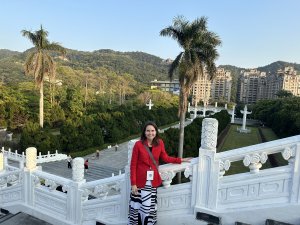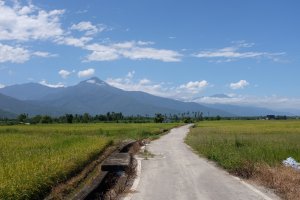In recent decades, dam removal has become a frequently-used strategy for restoring natural stream habitats because dams deteriorate river channels and often lead to decreased diversity of species. Taiwan has many short and steep rivers in the high mountains, where strong rainfall creates high water velocity. As a result, the government constructed many check dams to prevent the collapse of riverbanks and to lessen sediment transport to lower elevations. As of 1999, Taiwan had over 3,000 check dams.
The Chichiawan Stream and its tributaries in central Taiwan are the last refuge of the Formosan salmon. Dam establishment and agricultural development have degraded this habitat. These key factors are considered the main reason for the decline in the abundance and range of the Formosan salmon after the 1960s. The salmon population declined to about 200 individuals by 1984, at which time the Taiwanese government listed them as an endangered species. The salmon abundance in the entire Chichiawan basin has ranged between 1,000 and 5,500 since 2005.
The Chichiawan Stream basin had 11 check dams in 2000, covering a length of less than 10 km. These dams have disturbed the salmon’s habitat in multiple ways. For instance, the presence of dams creates reproductive isolation. The salmon have adapted to an environment characterized by typhoons, but the presence of dams creates a habitat with fewer large boulders to offer shelter during typhoons. In addition, dams prevent salmon from swimming back upstream after the typhoons flush them downstream, often resulting in mortality.
The conservation of the Formosan salmon has received more attention since the species received endangered status, and Shei-Pa National Park removed some of the dams as a part of the salmon conservation effort. In particular, four check dams were removed from the Gaoshan Stream, a tributary of the Chichiawan. All four check dams were partially removed between 1999 and 2001. I, along with Dr. Hsing-Juh Lin and PhD student Hao-Yen Chang, am using simulation modeling to quantify the effectiveness of the dam removal in the Gaoshan Stream and to investigate the future population dynamics after the dam removal, including the effect of anticipated increases in typhoon intensity.
The Gaoshan Stream is a third-order stream in the Wuling basin in Shei-Pa National Park in central Taiwan and is a tributary of the Chichiawan Stream on an upstream reach of the Dajia River. At an elevation of about 1700-1800 meters, it is considered a high mountain subtropical climate with stream temperatures normally below 15 °C. The catchment area consists of natural forests and is unaffected by agriculture, making this stream a good candidate for analyzing the effect of the dams on salmon abundance in isolation from other types of human interference.
Typhoons affect this region between May and September, causing flow discharges to increase during the spring and summer. Typhoons occur frequently in Taiwan, normally between May and September, and they play a central role in the population dynamics of the Formosan salmon. To account for the effect of typhoons in the model, the survival rates and the number of juvenile recruits are dependent on an annual discharge index, which is defined as the mean of the monthly average discharges (m3/s) from May to September.
The two parameters that depend on discharge (survival rates and number of juvenile recruits) were calibrated under two different scenarios: (1) the dams remain intact indefinitely, and (2) the dams are partially removed. Since the dams were removed by 2001, we used data from 1995-2000 to calibrate the parameters for the first scenario. Dam removal can be a traumatic event, and it often takes a few years for the habitat to stabilize, so we used data from after 2005 to calibrate the parameters under the second scenario. The model of Scenario 1 predicts that the salmon population would have declined to zero by around 2006 if the dams had not been partially removed. Since Scenario 2 projects salmon abundance in future years, we used forecasted discharge index values, selected randomly in each year based on historical data. This forecasting method accounts for correlation of flow between consecutive years, expected future increases in spring/summer discharge, and the potential for drought years.
Recent studies have observed a correlation between the global temperature and precipitation amounts. One study concludes that the quantity of precipitation in the top 10% of rainfall (in terms of intensity) may increase by 94% per degree increase in the global temperature. At the same time, lower intensity rain events would decrease by approximately 20% per degree increase in temperature. Since most of the high intensity rain events in Taiwan occur during spring and summer, we predict the discharge index (based on data from May to September) to gradually increase as the global temperature increases. Our discharge forecasting method gradually increases the forecasted index linearly from 2013 to 2035.
When the forecasted discharge levels were selected without the effect of climate change, the results show the population stabilizing in an oscillatory manner around 450 by 2017. When we included drought years and the climate change effect in the forecast, the model predicts that the population will begin declining after 2017.
Our analysis indicates that the partial dam removal in the Gaoshan Stream was an effective measure for salmon conservation. The model of Scenario 1 suggests that the salmon in the Gaoshan Stream would have disappeared by around 2006 if the dams had remained in place. In addition, the Scenario 2 model projects the salmon population to stabilize around 450 by 2017, which indicates growth from the most recent observed value of 262 in 2014. While the effects of climate change have the potential to diminish the salmon population, the effects would be even more severe in the model if the dams had remained intact because the parameters from Scenario 1 include lower survival rates and lower numbers of juvenile recruits compared to Scenario 2. It was not possible to make these comparisons for the Gaoshan Stream since the model predicted the population to decline to zero by 2006 in Scenario 1 even without the climate change effect in the model. Dam removal has the potential to reverse the declining population trends and to lessen the impact of higher intensity rainfall that may accompany climate change.
During my remaining time at National Chung Hsing University, we plan to apply similar types of modeling to the Chichiawan Stream and the Taoshan Stream, where check dams still remain. We hope to provide results that can be used to help make decisions regarding removal of more dams as a conservation effort. Many additional factors will be involved in these decisions. In particular, removal of check dams would result in more sediment transport downstream which would shorten the lifespan of dams that are used for irrigation purposes.
For the teaching component of my Fulbright grant, I taught a graduate course on ecological modeling in the Life Sciences Department during the fall semester. We covered a variety of algebraic techniques, so the students learned that they can apply relatively simple mathematics to create and analyze models. We used spreadsheets to program our models, so they could use familiar software in their analysis. Many of our examples were modeling population dynamics, including single species and interacting species. We also showed similar models can be applied in other settings, including lake pollution, plant growth, and the spread of a disease.
For the final project, each student selected a topic related to his or her thesis and then used modeling to do some analysis. This was their opportunity to apply the techniques learned in class in a real study, including how to pose questions, select modeling techniques, and analyze the models to answer their questions. For example, one student chose a project to model the amount of sewage pollution in a pool/stream system near campus. His Master’s thesis topic relates to the effect of pollution on fish, and he is using this model to determine the amount of time until the pollution reaches a tolerance threshold. He is also considering the effect of management scenarios that could keep the pollution level below this threshold.
At the beginning of the semester, many of my students expressed a dislike of mathematics and apprehension about this class (not only because of the math, but also the English). They picked up the modeling and analysis techniques very well throughout the semester; I have been extremely impressed with their work and am looking forward to reading their final reports. I am also looking forward to our class next semester, in which we will apply techniques from calculus and differential equations to modeling. I hope many of the students develop an interest in continuing to apply math in their future research.
Laurie Battle is a professor of mathematics at Montana Tech specializing in mathematical modeling. She is a Fulbright Senior Scholar at National Chung Hsin University in Taichung, where she researches endangered Formosan landlocked salmon and teaches graduate courses on different modeling techniques.





